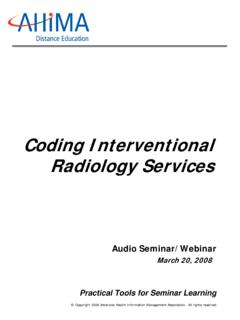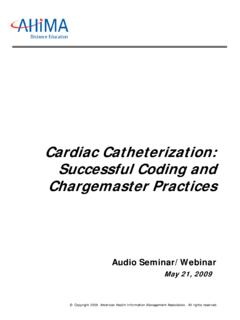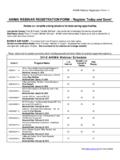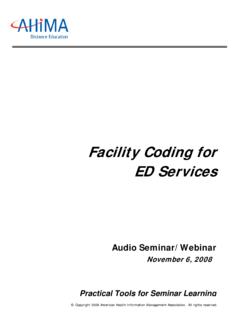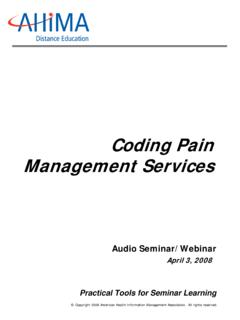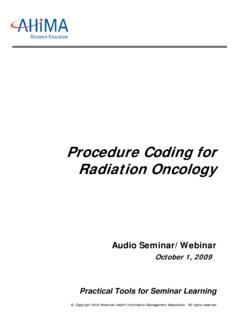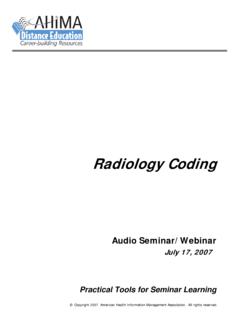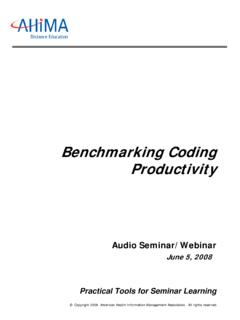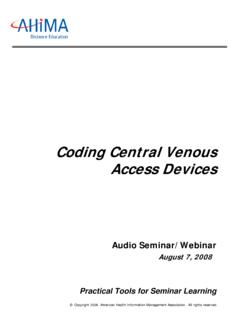Transcription of Emergency Department Coding - AHIMA
1 Emergency Department Coding Audio Seminar/Webinar October 2, 2007. Practical Tools for Seminar Learning Copyright 2007 American Health Information Management Association. All rights reserved. Disclaimer The American Health Information Management Association makes no representation or guarantee with respect to the contents herein and specifically disclaims any implied guarantee of suitability for any specific purpose. AHIMA has no liability or responsibility to any person or entity with respect to any loss or damage caused by the use of this audio seminar, including but not limited to any loss of revenue, interruption of service, loss of business, or indirect damages resulting from the use of this program. AHIMA makes no guarantee that the use of this program will prevent differences of opinion or disputes with Medicare or other third party payers as to the amount that will be paid to providers of service.
2 CPT five digit codes, nomenclature, and other data are copyright 2006 American Medical Association. All Rights Reserved. No fee schedules, basic units, relative values or related listings are included in CPT. The AMA assumes no liability for the data contained herein. As a provider of continuing education, the American Health Information Management Association ( AHIMA ) must assure balance, independence, objectivity and scientific rigor in all of its endeavors. AHIMA is solely responsible for control of program objectives and content and the selection of presenters. All speakers and planning committee members are expected to disclose to the audience: (1) any significant financial interest or other relationships with the manufacturer(s) or provider(s) of any commercial product(s) or services(s) discussed in an educational presentation; (2) any significant financial interest or other relationship with any companies providing commercial support for the activity; and (3) if the presentation will include discussion of investigational or unlabeled uses of a product.
3 The intent of this requirement is not to prevent a speaker with commercial affiliations from presenting, but rather to provide the participants with information from which they may make their own judgments. AHIMA 2007 Audio Seminar Series i Faculty Lynda Starbuck, MS, RHIA. Ms. Starbuck is the national manager of auditing and education for Smart Documentation Solutions (SDS) Healthport. Lynda has over 15 years experience in ED Coding , RBRVS, evaluation and management, and proper physician and nursing documentation to aid in ED. Coding and compliance. Becky Wilson, CCS, CPC. Ms. Wilson is a senior Emergency Department auditor with Healthcare Coding and Consulting Services (HCCS). Ms. Wilson has seven years of experience in Emergency Department Coding , and has been an auditor of Emergency Department records for four years.
4 AHIMA 2007 Audio Seminar Series ii Table of Contents Disclaimer .. i Faculty ..ii Objectives .. 1. OPPS Facility Charge 1. E/M Determination .. 2. Critical Care .. 3. Cardiopulmonary Resuscitation .. 3. Intubation .. 4. Burns .. 4. Rule of 5. Three Types of Burns .. 7. Burn 7. Polling Question #1 .. 8. Fracture Care Services .. 8. Splints and Strapping .. 9. When to Code Splints (facility) ..10. ED Treatment Rooms ..11. Polling Question #2 ..11. Problem ED Procedures I and Ds ..12. Suture Repairs ..12. Fish Hook IV Hierarchy ..13. Documentation ..14. IV Coding Decision Trees ..14. 2008 ICD-9-CM Diagnosis Codes Herpes Simplex ..16. Coronary Avian Influenza Virus ..17. Dysphagia ..17. Ascites ..18. Personal History Codes.
5 18. Family History Codes ..19. Old Codes Worth Mentioning ..19. Medical Necessity ..20. Supporting Coding Modifiers ..21. Modifier -25 ..22. Modifier -52 ..22. Modifier -59 ..23. Anatomical Modifiers ..23. OPPS Changes for 2008 ..24. CMS-2008 E/M Guideline Case Study #1 ..25. Case Study #2 ..25. Case Study #3 ..26. Case Study #4 ..26. Resources ..27. Audience Questions Appendix ..31. CE Certificate Instructions ..32. AHIMA 2007 Audio Seminar Series Table of Contents AHIMA 2007 Audio Seminar Series Emergency Department Coding Notes/Comments/Questions Objectives What's included in Critical Care, CPR, and Intubation and Fracture Care for facilities Proper Burn Coding When to code Splints and Strapping What's considered a Treatment Room Identify Problem Procedures Guidance for Facility E/M.
6 Simplify IV Coding Identify New Diagnosis Codes Pertaining to the ER. Understand Coding for Medical Necessity Proper Use of Modifiers OPPS and how it affects you in FY 2008 1. OPPS Facility Charge Guidelines In the outpatient arena of healthcare, CMS moved to a system much like DRGs called APCs. The difference is that only one DRG is paid, whereas multiple APC payments may be made for one visit. CMS continues to try to construct facility E/M. levels to reflect the acuity of care patients receive (national guidelines). Until then, each hospital is allowed to construct their own facility levels based on the acuity of care patients receive and to some extent the resources provided. 2. AHIMA 2007 Audio Seminar Series 1.
7 CPT Codes Copyright 2006 by AMA. All Rights Reserved Emergency Department Coding Notes/Comments/Questions Facility Charge Guidelines CMS moving away from fee for service OPPS/APCs caused restructuring of ED. levels Facility levels reflect the acuity of care the patient receives Status indicator describes how services are treated under OPPS for hospital outpatient departments 3. Facility E/M Determination Five levels . CPT 99281 99285. Critical care CPT 99291 code also any procedures performed Third party payers may not pay additional hours of critical care on the facility side All procedures performed by physicians and ancillary staff must be coded Review nursing notes for procedures performed 4. AHIMA 2007 Audio Seminar Series 2.
8 CPT Codes Copyright 2006 by AMA. All Rights Reserved Emergency Department Coding Notes/Comments/Questions Critical Care Beginning in 2007, nurses must also document duration of critical care time in order to charge E/M 99291. (Less than 30 minutes of care does not support critical care). Remember if it is not documented, it did not happen. 5. Cardiopulmonary Resuscitation Cardiopulmonary Resuscitation (CPT 92950) found in cardiac arrest only includes the actual bagging of the patient and external cardiac massage. Drugs given during cardiac resuscitation should be coded separately using CPT 90774 / 90775. 6. AHIMA 2007 Audio Seminar Series 3. CPT Codes Copyright 2006 by AMA. All Rights Reserved Emergency Department Coding Notes/Comments/Questions Intubation Endotracheal Intubation (CPT 31500) is an Emergency procedure done to establish an airway.
9 Rapid Sequence Intubation (RSI) includes total body paralysis in order to control the scene, paralyze the vocal cords (muscle relaxation) and protect the airway from aspiration. For RSI IVP drugs are used and should be coded in addition to CPT. 31500. 7. Burns The burn patient has the same priorities as all other trauma patients - Assess airway, breathing, circulation, disability, and exposure - Essential management points stop the burning, good IV access and early fluid replacement - Severity of the burn is determined by burned surface are, depth of burn and determining the percentage of the burn 8. AHIMA 2007 Audio Seminar Series 4. CPT Codes Copyright 2006 by AMA. All Rights Reserved Emergency Department Coding Notes/Comments/Questions Rule of 9s Commonly used to estimate the burned surface area in adults The body is divided into anatomical regions that represent 9% (or multiples of 9%) of the total body surface.
10 The outstretched palm and fingers approximates to 1% of the body surface area. If the burned area is small , assess how many times your hand covers the area Morbidity and mortality rises with increased burned surface area. 9. Estimating the Burned Surface Area in Adults Rule of 9's 10. AHIMA 2007 Audio Seminar Series 5. CPT Codes Copyright 2006 by AMA. All Rights Reserved Emergency Department Coding Notes/Comments/Questions Estimating the Burned Surface Area in Children Rule of 9's 11. Burns continued . Burns greater than 15% in an adult or greater than 10% in a child, or any burn occurring in the elderly or very young are serious 12. AHIMA 2007 Audio Seminar Series 6. CPT Codes Copyright 2006 by AMA. All Rights Reserved Emergency Department Coding Notes/Comments/Questions Three Types of Burns code to the highest degree per site First degree burn erythema, pain, absence of blisters Second degree (Partial Thickness).
